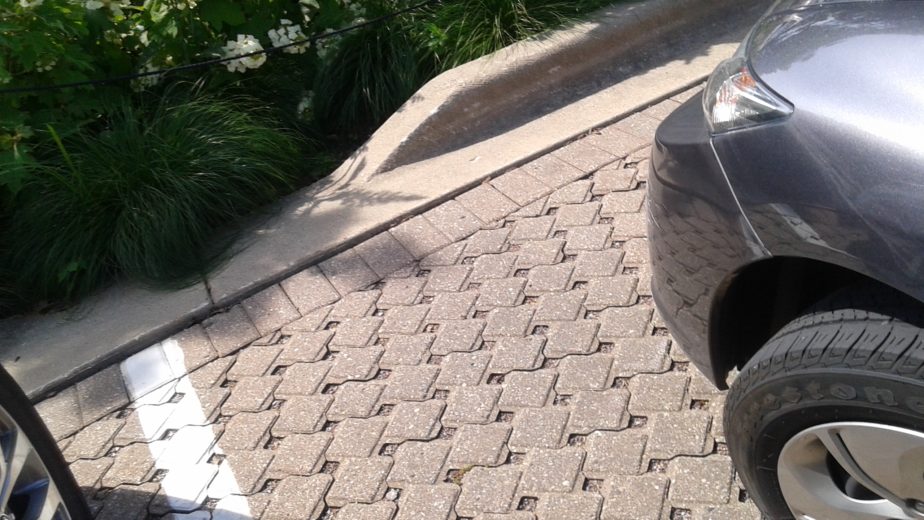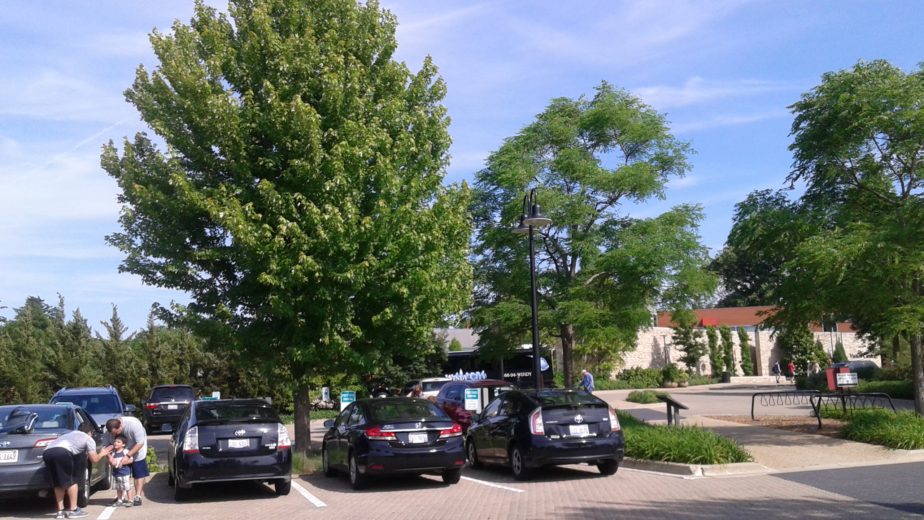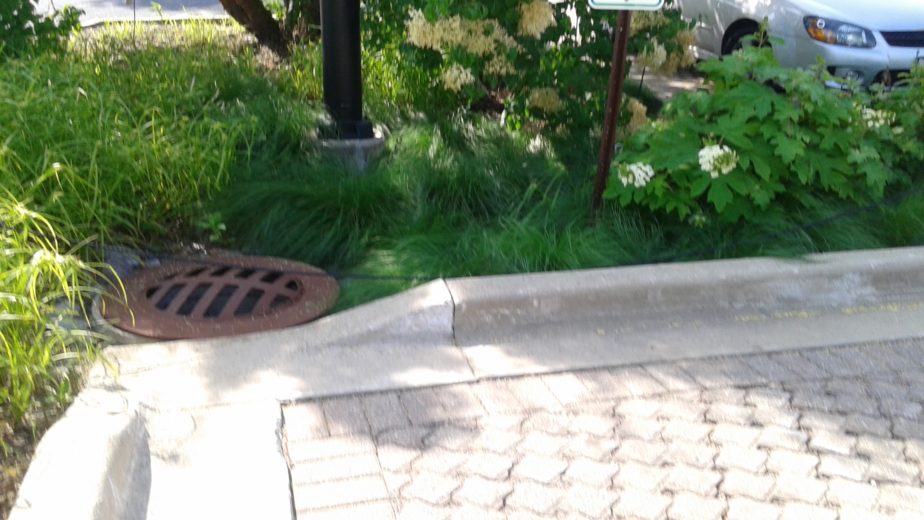Research Shows Trees in Bioswales Provide Significant Stormwater Benefits
When we talk about the value of urban trees and soils as a stormwater management tool, the contribution of the trees is often considered secondary. Soil will, of course, store significant amounts of runoff all on its own. However, new research at the Morton Arboretum in Lisle, IL, has found that trees actually provided the largest proportion of their bioswales' stormwater benefits (Scharenbroch et al, 2016). ). In addition to significantly contributing to stormwater benefits, trees also provide many other benefits soil alone does not.
The bioswales at the Morton Arboretum were installed in the late 1990s as part of a redevelopment of the Arboretum's visitor center, main entrance, and parking lot. Redevelopment of the parking lot included numerous best management practices (BMPs) to capture and filter rainwater before entering the adjacent Meadow Lake and East Branch of the DuPage River. Scharenbroch et al (2016) describe the parking lot as follows:
"The 2-ha green parking lot includes bioswale medians and permeable pavement and has 500 car parking spots. Permeable pavers cover 1.9 ha of the parking lot, with 1.6 ha in Ecoloc permeable interlocking concrete pavers (Unilock) and 0.3 ha in UNI-Anchorlock solid interlocking pavers (Unilock). Bioswales in the green parking lot contain single- and multi-stemmed deciduous and evergreen trees, shrubs, and herbaceous plants. The bioswales are 3 m wide and graded at a 3:1 slope from the edge of curb to the swale bottom (30 cm)… The bioswales receive water from the parking lot in 1-m gaps spaced 9 m apart.
Planting soil (46 cm) in the bioswales was a constructed sandy loam (60% sand and 10% clay) with 5% coarse organic matter and pH 5.5 to 7.5 at installation. Perforated high-density polyethylene storm sewers (0.76 m in diameter) are under the planting soil within the CA1 sub-base to handle a 10-yr storm event. The storm sewers are interconnected with catch basins for sediment and pitched (0.5%) toward a water-level control structure, which drains to Meadow Lake. The control structure can restrict flow out of the storm sewer system to allow for additional time to infiltrate into the sub-base. Alternatively, the structure can be opened to allow for rapid flow when the sub-base is not draining quickly enough to maintain the pavement integrity."
More than 10 years after the parking lot and the trees were installed, from 2012-2014, Scharenbroch et al (2016), studied the water budget of the bioswales. They also studied the condition of trees in the bioswales, compared to nearby control trees, to assess the effects of the bioswale environment on tree health. Their results strongly support the use of trees in bioswales. Let's look at why.
Water budget
Scharenbroch et al (2016) conducted a detailed examination of the parking lot water budget from June through September 2014. Water inputs included precipitation and irrigation. Water outputs included transpiration, soil storage, discharge, and unmeasured.
They found that "Tree transpiration accounted for 46 to 72% of the water inputs in precipitation and irrigation. Soil storage and discharge were minimal, accounting for 4.5 to 10% and 0.02 to 1.7% of water inputs, respectively. The total unmeasured stock accounted for 18 to 49% of water inputs. The unmeasured stock was likely a combination of shrub and herbaceous transpiration leaching out of the soil, uncaptured runoff from the site, plant storage, and evaporation" (bold added).
They also found that some tree species contributed more to bioswale benefits than others, depending on three factors: "(i) the rate of stomatal conductance (indicative of rate of transpiration), (ii) total leaf area and mature size of the tree, and (iii) the health and condition of the tree" (italics added). Of the species they measured, bur oak (Quercus macrocarpa), had greater stomatal conductance than the other 6 species (Acer campestre L., Acer miyabei 'Morton' Acer x freemanii 'Jeffersred', Carpinus caroliniana 'Walter', Cercis canadensis L. and Syringa pekinsis 'Morton').
Effects of Bioswale Conditions on Tree Health
Scharenbroch et al (2016) also compared overall mean diameter growth rate and overall mean tree condition index (based on sum of scores for vitality, quality, opacity, and twig growth, see paper for more detail) of trees in bioswales to control trees of the same species, age, and source, that were not in bioswales, but had similar light availability, distance to hard space, and management.
Overall mean diameter growth was significantly greater for trees planted in bioswales. Mean tree condition index was not statistically different between bioswale trees and control trees. They, therefore, conclude that the bioswale environment, with its fluctuating water levels, was not stressful for the species studied. May et al (2006), similarly found that trees performed well in stormwater BMPs. They found greater growth in height and root density in trees irrigated with stormwater, versus those irrigated with tap water, presumably due to the high levels of nutrients in the stormwater runoff. Excess nutrients that are considered a pollutant in stormwater runoff, appear to be an asset when used to water trees.
Conclusion
Recent research at the Morton Arboretum, where tree transpiration accounted for 46 to 72% of the water inputs into parking lot bioswales during summer months, confirms the significant potential of trees to maximize the performance of BMPs. Not only does this transpiration provide significant stormwater benefits, it also has tremendous potential to help mitigate the Urban Heat Island Effect, cooling the air at the same time it is taking stormwater runoff off line.
This research also highlights the importance of species selection and providing optimal tree growing conditions to maximize stormwater benefits, as the magnitude of stormwater benefits was found to depend on each species' rate of transpiration, leaf area and mature size of a tree, and health of the tree.
Long-term studies on the contribution of more species and sizes of trees to stormwater management would be invaluable.
References
May, P. B.; Breen, P. F.; Denman, L. (2006). "An Investigation of the Potential to Use Street Trees and Their Root Zone Soils to Remove Nitrogen from Urban Stormwater." In: Delectic, Ana (Editor); Fletcher, Tim (Editor). 7th International Conference on Urban Drainage Modelling and the 4th International Conference on Water Sensitive Urban Design; Book of Proceedings. [Clayton, Vic.]: Monash University: 109-116.
Scharenbroch, Bryant C. , Justin Morgenroth, and Brian Maule. 2016. Tree Species Suitability to Bioswales and Impact on the Urban Water Budget. J. Environ. Qual. Jan 45(1):199-206.



